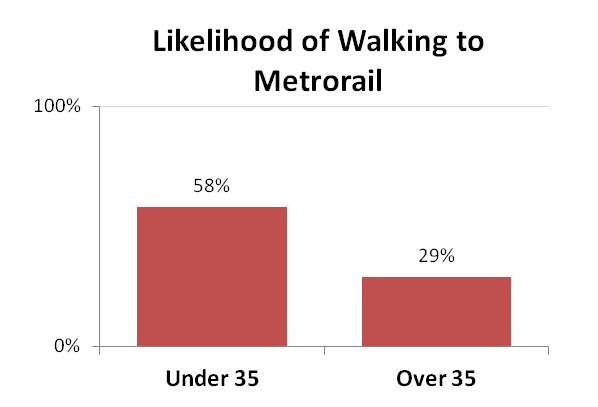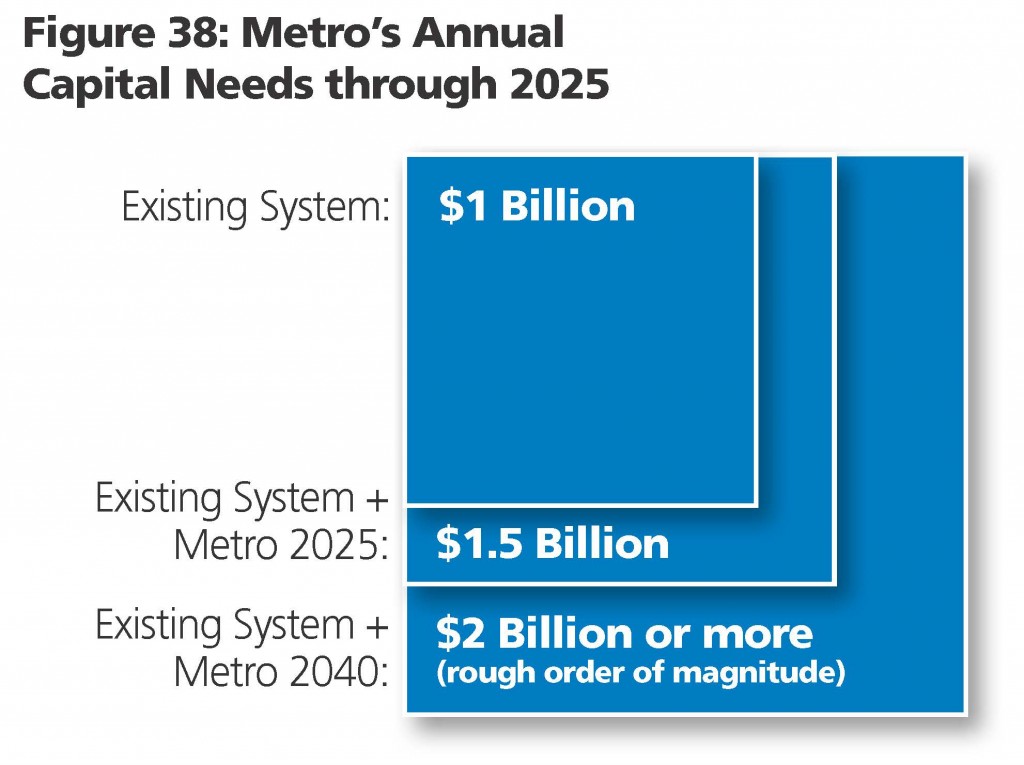Walk access to Metrorail has increased 15% over the last 5 years, especially from those living within a half-mile of the station.
So more rail riders are choosing to walk to their Metrorail station, according to the 2012 Metrorail Passenger Survey. But who are these pedestrians?
Around 40% of Metrorail customers in the AM peak walk to the station. The survey found that younger people are much more likely to walk, with those under 35 were nearly twice as likely to walk to the train as those over 35:
 However, younger Metrorail riders are also more likely to live within walking distance of their Metrorail station. Half of all riders under 35 live within a half-mile Metrorail, while 22% of those over 35 do. Younger people in our region generally are slightly more likely to live near Metrorail – 15% of everyone under 35 in the region lives within a half-mile of Metrorail, 12% for those over 35. The chart below shows how younger riders tend to live closer to Metrorail: Read more…
However, younger Metrorail riders are also more likely to live within walking distance of their Metrorail station. Half of all riders under 35 live within a half-mile Metrorail, while 22% of those over 35 do. Younger people in our region generally are slightly more likely to live near Metrorail – 15% of everyone under 35 in the region lives within a half-mile of Metrorail, 12% for those over 35. The chart below shows how younger riders tend to live closer to Metrorail: Read more…
Like many of the nation’s transit  agencies, Metro must rebuild its once-new capital assets as they wear down and deteriorate after decades of use. Metro could feasibly use every penny in its capital budget for years to come just reducing its backlog of maintenance issues. Moreover, Metro also needs to ensure that the system is able to overcome the capacity constraints that come with a regional population expected to swell in both the central core and the suburbs in the years ahead. And on top of this, Metro will need to address calls for entirely new service in many areas of the region. Once Metro is rehabilitated, the system will require a stable level of investment to maintain a state of good repair as it continues to age and deteriorate. Metro estimates that $1 billion (in 2012 dollars) per year is necessary to support and maintain the existing system, even after rehabilitation. Metro 2025 will expand the core and system capacity, as well as ensure that the region’s capital investments are successful. This requires an additional $500 million, on average, in annual capital funding through 2025.
agencies, Metro must rebuild its once-new capital assets as they wear down and deteriorate after decades of use. Metro could feasibly use every penny in its capital budget for years to come just reducing its backlog of maintenance issues. Moreover, Metro also needs to ensure that the system is able to overcome the capacity constraints that come with a regional population expected to swell in both the central core and the suburbs in the years ahead. And on top of this, Metro will need to address calls for entirely new service in many areas of the region. Once Metro is rehabilitated, the system will require a stable level of investment to maintain a state of good repair as it continues to age and deteriorate. Metro estimates that $1 billion (in 2012 dollars) per year is necessary to support and maintain the existing system, even after rehabilitation. Metro 2025 will expand the core and system capacity, as well as ensure that the region’s capital investments are successful. This requires an additional $500 million, on average, in annual capital funding through 2025.
Certainly, increases in the overall size and scope of the system will also have an impact on operating costs, which would grow to some degree when new rail cars, buses, and service are put in place. These operating costs may grow in line with the proportional size of system expansion or at a lower rate, especially if increases in reliability and the increased attractiveness of transit to today’s non-riders has a disproportionate effect on ridership, mode choice, and revenues for modes that have high farebox recovery ratios today and/or where existing demand is already delivering more revenue than operating costs.
Read more…
 However, younger Metrorail riders are also more likely to live within walking distance of their Metrorail station. Half of all riders under 35 live within a half-mile Metrorail, while 22% of those over 35 do. Younger people in our region generally are slightly more likely to live near Metrorail – 15% of everyone under 35 in the region lives within a half-mile of Metrorail, 12% for those over 35. The chart below shows how younger riders tend to live closer to Metrorail: Read more…
However, younger Metrorail riders are also more likely to live within walking distance of their Metrorail station. Half of all riders under 35 live within a half-mile Metrorail, while 22% of those over 35 do. Younger people in our region generally are slightly more likely to live near Metrorail – 15% of everyone under 35 in the region lives within a half-mile of Metrorail, 12% for those over 35. The chart below shows how younger riders tend to live closer to Metrorail: Read more…


Recent Comments